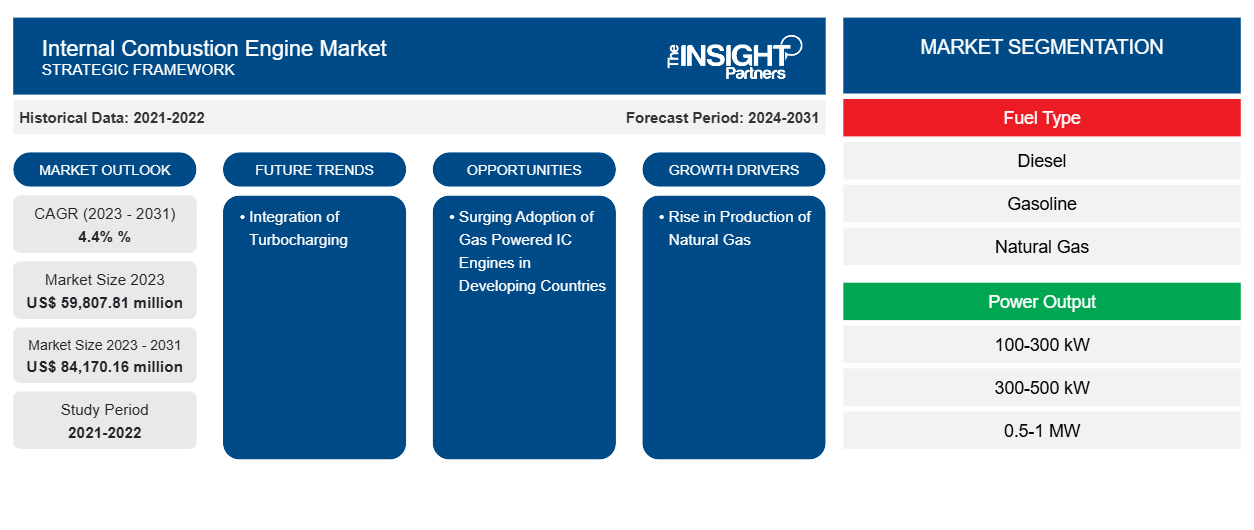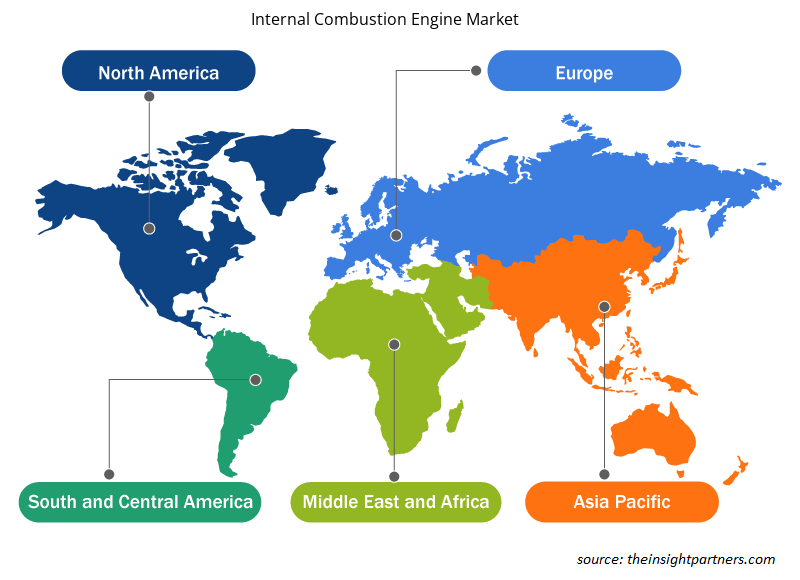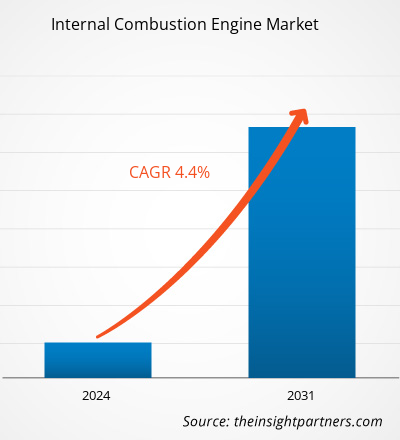The Internal Combustion Engine Market size is projected to reach US$ 84,170.16 million by 2031 from US$ 59,807.81 million in 2023. The market is expected to register a CAGR of 4.4% % in 2023–2031. The fueling acceptance of natural gas for power generation in, industrial, and commercial sectors is likely to remain key internal combustion engine market trends.
Internal Combustion Engine Market Analysis
Expanding demand for natural gas-powered engines in applications in heavy industries such as metal, food processing, and chemicals is driving the market significantly. Further, developing concerns regarding emissions and improving regulatory standards are assisting the market growth in the automotive sector. In the internal combustion engine market, automotive, mid-stream oil and gas, remote, heavy industries, light manufacturing, utilities, off-road, datacenters, MUSH, and commercial are end users.
Internal Combustion Engine Market Overview
Increasing global warming is a major environmental concern worldwide. The governments of various nations are imposing certain restrictions to control the emissions of diesel and petrol engines; thus, the growing emphasis on environment-friendly alternatives is compelling engine manufacturers to develop technologies to make internal combustion engines more effective and produce less emissions. Manufacturers and customers are now shifting their attention towards the application of alternate fuels in internal combustion engines. For example, natural gas-driven internal combustion engines emit less emissions to produce a necessary amount of power with high efficiency. The emission monitoring and regulatory agencies from various nations are enforcing stringent regulations on the usage of diesel engines and generators. To meet these regulatory standards, several industries are implementing gas engines and generators for power generation.
Customize This Report To Suit Your Requirement
You will get customization on any report - free of charge - including parts of this report, or country-level analysis, Excel Data pack, as well as avail great offers and discounts for start-ups & universities
Internal Combustion Engine Market: Strategic Insights

- Get Top Key Market Trends of this report.This FREE sample will include data analysis, ranging from market trends to estimates and forecasts.
You will get customization on any report - free of charge - including parts of this report, or country-level analysis, Excel Data pack, as well as avail great offers and discounts for start-ups & universities
Internal Combustion Engine Market: Strategic Insights

- Get Top Key Market Trends of this report.This FREE sample will include data analysis, ranging from market trends to estimates and forecasts.
Internal Combustion Engine Market Drivers and Opportunities
Rise in Production of Natural Gas to Favour Internal Combustion Engine Market
The demand for gas engines is increasing in the power generation sector with new emission control policies. The industrial sector, including metals, chemicals, and manufacturing industries, is a major contributor to the escalating demand for gas engines. The generation of natural gas, which is one type of fuel required for internal combustion engines, is growing at a significant rate. The industrial sector, including metals, chemicals, and manufacturing industries, is a major contributor to the accelerating demand for internal combustion engines. The generation of natural gas, which is necessary for operating internal combustion engines, is rising at a substantial rate. Major applications such as electricity generation, heating, and vehicle functioning are strengthening the requirement for natural gas internal combustion engines. Hence, to offer a resolution for sudden power outages, utility service companies are utilizing gas generators to manage peak loads. Thus, the constant surge in demand from developing countries is one of the key factors driving the internal combustion engine market growth.
Rising Adoption of Gas Engines in Developing Nations– An Opportunity in the Gas Engine Market
The increase in population and the lack of supporting infrastructure for electric technologies are the major factors supporting the internal combustion engine market. Electric devices, electric motors, solar plants, and wind projects are more costly than gas engines, which is compelling the preference of various nations toward gas engines as an environment-friendly alternative. Further, developments in the emission standards for diesel engines for which various end-use industries are shifting to gas engines for low emissions. Emerging nations are effectively inclining towards adopting natural gas for power generation. Thus, the growing popularity of natural gas is anticipated to offer lucrative opportunities for the internal combustion engine market.
Internal Combustion Engine Market Report Segmentation Analysis
Key segments that contributed to the derivation of the internal combustion engine market analysis are fuel type, power output, and end-user.
- Based on the fuel type, the internal combustion engine market has been divided into diesel, gasoline, and natural gas. The gasoline segment held a larger market share in 2023.
- In terms of power output, the market has been segmented into 100-300 kW, 300-500 kW, 0.5-1 MW, 1-5 MW, 5-15 MW, 15-25 MW, and 25 MW and above. The 100-300 kW segment dominated the market in 2023.
- In terms of end-user, the market has been segmented into industrial, marine, power generation, aerospace, and defense, automotive, off-road, and others. The automotive segment dominated the market in 2023.
- In terms of cylinders, the market has been segmented into 1, 2, 3, and 4. The 4 cylinders segment dominated the market in 2023.
Internal Combustion Engine Market Share Analysis by Geography
The geographic scope of the Internal Combustion Engine Market report is mainly divided into five regions: North America, Asia Pacific, Europe, Middle East & Africa, and South America/South & Central America.
The internal combustion engine market in the Asia Pacific is segmented into India, Japan, Australia, China, South Korea, and the Rest of Asia Pacific. China is one of the leading internal combustion engine manufacturing countries in this region, while India and Japan are also considered substantial contributors to regional growth. Due to the increasing population in developing nations like India and China, there is an increasing demand for electricity; thus, end users such as power generating plants, remote plants and manufacturing industries are utilizing internal combustion engines for power generation. The rising number of manufacturing companies in India and China is characterized by the mass production of internal combustion engines for automobile and power generation, owing to the substantial availability of skilled human resources. Due to the high cost of electric energy engines and the lack of supporting infrastructure, there is a rise in the adoption of conventional internal combustion engines, which has supplemented the market growth. Moreover, governments of various nations in the region are majorly promoting natural gas application in internal combustion engines for low emissions.
Internal Combustion Engine Market Regional Insights
The regional trends and factors influencing the Internal Combustion Engine Market throughout the forecast period have been thoroughly explained by the analysts at The Insight Partners. This section also discusses Internal Combustion Engine Market segments and geography across North America, Europe, Asia Pacific, Middle East and Africa, and South and Central America.

- Get the Regional Specific Data for Internal Combustion Engine Market
Internal Combustion Engine Market Report Scope
| Report Attribute | Details |
|---|---|
| Market size in 2023 | US$ 59,807.81 million |
| Market Size by 2031 | US$ 84,170.16 million |
| Global CAGR (2023 - 2031) | 4.4% % |
| Historical Data | 2021-2022 |
| Forecast period | 2024-2031 |
| Segments Covered |
By Fuel Type
|
| Regions and Countries Covered | North America
|
| Market leaders and key company profiles |
Internal Combustion Engine Market Players Density: Understanding Its Impact on Business Dynamics
The Internal Combustion Engine Market is growing rapidly, driven by increasing end-user demand due to factors such as evolving consumer preferences, technological advancements, and greater awareness of the product's benefits. As demand rises, businesses are expanding their offerings, innovating to meet consumer needs, and capitalizing on emerging trends, which further fuels market growth.
Market players density refers to the distribution of firms or companies operating within a particular market or industry. It indicates how many competitors (market players) are present in a given market space relative to its size or total market value.
Major Companies operating in the Internal Combustion Engine Market are:
- INNIO Jenbacher GmBH & Co OG
- Caterpillar Inc.
- Cummins Inc.
- Fairbanks Morse, LLC
- Kawasaki Heavy Industries, Ltd.
- Liebherr
Disclaimer: The companies listed above are not ranked in any particular order.

- Get the Internal Combustion Engine Market top key players overview
Internal Combustion Engine Market News and Recent Developments
The Internal Combustion Engine Market is evaluated by gathering qualitative and quantitative data post primary and secondary research, which includes important corporate publications, association data, and databases. The following is a list of developments in the market for innovations, business expansion, and strategies:
- In May 2022, Caterpillar Inc. announced a three-year project with Minnesota-based District Energy St. Paul to demonstrate a hydrogen-driven combined heat and power system. (Source: Caterpillar Inc., Press Release/Company Website/Newsletter)
- In May 2024, Cummins Inc. announced the initiation of production of its hydrogen internal combustion engines for Tata Motors in Jamshedpur, India. (Source: Cummins Inc., Press Release/Company Website/Newsletter)
Internal Combustion Engine Market Report Coverage and Deliverables
The “Internal Combustion Engine Market Size and Forecast (2021–2031)” report provides a detailed analysis of the market covering the following areas:
- Internal Combustion Engine Marketsize and forecast at global, regional, and country levels for all the key market segments covered under the scope
- Market dynamics such as drivers, restraints, and key opportunities
- Internal Combustion Engine Market Trends
- Detailed PEST and SWOT analysis
- Internal Combustion Engine Market analysis covering key market trends, Global and regional framework, major players, regulations, and recent market developments
- Internal Combustion Engine Industry, landscape and competition analysis, covering market concentration, heat map analysis, prominent players, and recent developments
- Detailed company profiles
- Historical Analysis (2 Years), Base Year, Forecast (7 Years) with CAGR
- PEST and SWOT Analysis
- Market Size Value / Volume - Global, Regional, Country
- Industry and Competitive Landscape
- Excel Dataset
Testimonials
Reason to Buy
- Informed Decision-Making
- Understanding Market Dynamics
- Competitive Analysis
- Identifying Emerging Markets
- Customer Insights
- Market Forecasts
- Risk Mitigation
- Boosting Operational Efficiency
- Strategic Planning
- Investment Justification
- Tracking Industry Innovations
- Aligning with Regulatory Trends
Yes! We provide a free sample of the report, which includes Report Scope (Table of Contents), report structure, and selected insights to help you assess the value of the full report. Please click on the "Download Sample" button or contact us to receive your copy.
Absolutely — analyst assistance is part of the package. You can connect with our analyst post-purchase to clarify report insights, methodology or discuss how the findings apply to your business needs.
Once your order is successfully placed, you will receive a confirmation email along with your invoice.
• For published reports: You’ll receive access to the report within 4–6 working hours via a secured email sent to your email.
• For upcoming reports: Your order will be recorded as a pre-booking. Our team will share the estimated release date and keep you informed of any updates. As soon as the report is published, it will be delivered to your registered email.
We offer customization options to align the report with your specific objectives. Whether you need deeper insights into a particular region, industry segment, competitor analysis, or data cut, our research team can tailor the report accordingly. Please share your requirements with us, and we’ll be happy to provide a customized proposal or scope.
The report is available in either PDF format or as an Excel dataset, depending on the license you choose.
The PDF version provides the full analysis and visuals in a ready-to-read format. The Excel dataset includes all underlying data tables for easy manipulation and further analysis.
Please review the license options at checkout or contact us to confirm which formats are included with your purchase.
Our payment process is fully secure and PCI-DSS compliant.
We use trusted and encrypted payment gateways to ensure that all transactions are protected with industry-standard SSL encryption. Your payment details are never stored on our servers and are handled securely by certified third-party processors.
You can make your purchase with confidence, knowing your personal and financial information is safe with us.
Yes, we do offer special pricing for bulk purchases.
If you're interested in purchasing multiple reports, we’re happy to provide a customized bundle offer or volume-based discount tailored to your needs. Please contact our sales team with the list of reports you’re considering, and we’ll share a personalized quote.
Yes, absolutely.
Our team is available to help you make an informed decision. Whether you have questions about the report’s scope, methodology, customization options, or which license suits you best, we’re here to assist. Please reach out to us at sales@theinsightpartners.com, and one of our representatives will get in touch promptly.
Yes, a billing invoice will be automatically generated and sent to your registered email upon successful completion of your purchase.
If you need the invoice in a specific format or require additional details (such as company name, GST, or VAT information), feel free to contact us, and we’ll be happy to assist.
Yes, certainly.
If you encounter any difficulties accessing or receiving your report, our support team is ready to assist you. Simply reach out to us via email or live chat with your order information, and we’ll ensure the issue is resolved quickly so you can access your report without interruption.





















 Get Free Sample For
Get Free Sample For